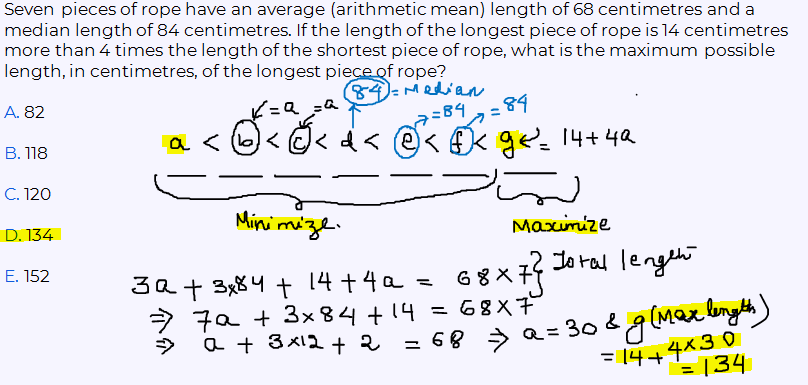Hi all!
 Question : Seven pieces of rope have an average (arithmetic mean) length of 68 centimeters and a median length of 84 centimeters. If the length of the longest piece of rope is 14 centimeters more than 4 times the length of the shortest piece of rope, what is the maximum possible length, in centimeters, of the longest piece of rope?
Question : Seven pieces of rope have an average (arithmetic mean) length of 68 centimeters and a median length of 84 centimeters. If the length of the longest piece of rope is 14 centimeters more than 4 times the length of the shortest piece of rope, what is the maximum possible length, in centimeters, of the longest piece of rope?
Now that is a classic and elegant question to test your application skills of
maximization and minimization.
This question shall also test your conceptual understanding of
Mean and Median.So all in all, if you are able to get this right under 2 min then you are perfectly on the road ahead!!
In case you have not, then lets try to have the necessary takeaways from the question and ensure that you would be able to use this learning in the next questions of Maximization & Minimization.
 Core GMAT concept:
Core GMAT concept: Minimize (n-1) elements to maximize 1 element out of n elements and vice versa.
Also know that the middle value in an arranged set is called the
median. Since Arithmetic Mean cannot give a precise data representation when there are
extreme values in a set, the statistical tool of Median came into existence.
When n is 'odd' Median is the middle value
and
when n is 'even' median is he average of the two middle values in an arranged set(arranged in ascending or descending order)
When arranged in an ascending order, values to the left of median can be < or = the median and values to the right of median can be > or = the median.
Now coming back to the question, lets arrange these 7 pieces in ascending order of length.
 GMAT Tip:
GMAT Tip: The lengths of the segments may not be integers and hence do not use the approach of moving through elimination.
So a < b < c < d < e < f < g where a is the shortest piece and g is the longest.
According to the Question Stem g = 14 + 4a
Eliminate option A as the answer choice as longest piece cannot be lesser than the median! So we have 4 options of which 3 are incorrect now.
Sum of the elements= Average * number of elements and here substituting the corresponding values we have Sum = 68 * 7
Since we have a constant sum, we have to maximize on g by minimizing on the remaining lengths.
The median of 7 elements(odd number) would be (7 + 1)/2 = 4th element which is 84.
Thus the minimum length we can assign to each of the 3 pieces to the left of the 4th piece are a, a, a each as a is the smallest in length according to our arrangement.
So we have a , a , a , 84 all arranged.
What about the next 3 pieces?
Since we intend to minimize, the next two pieces after 84 can be assigned with the same value of 84 each.
(Refer to the GMAT Core Concept explained above)Now the arrangement is a , a , a , 84 ,84 , 84 , 14+4a (arrangement in ascending order)
The sum of these pieces is
a + a + a + 84 + 84 + 84 + 14 + 4a = 68 * 7
=> 7a + 3*84 + 14 = 68 * 7
Now divide the LHS & RHS by 7
 GMAT Tip :
GMAT Tip : Try not to calculate immediately on GMAT but rather bring it to the last step and then check if you can minimize on calculations.
=> a + 3*12 + 2 = 68
=> a = 68 -38 = 30
And hence the
maximum value or the length of the longest piece is 4a + 14
= 4 * 30 +14
= 134
(option d)


GMAT is a combination of logic, strategies and decisive thinking and all these elements when applied in the right way, add up to make you a smart problem solver and all this through a finite box of concepts.
So try not to just solve problems but be flexible with the process and learn "thinking through"! This will help you sail through GMAT with ease and elegance.
Lets see you on the other side of green
 Devmitra Sen
Devmitra Sen
GMAT Quant SME
Attachments

Crackverbal.PNG [ 39.98 KiB | Viewed 2260 times ]






